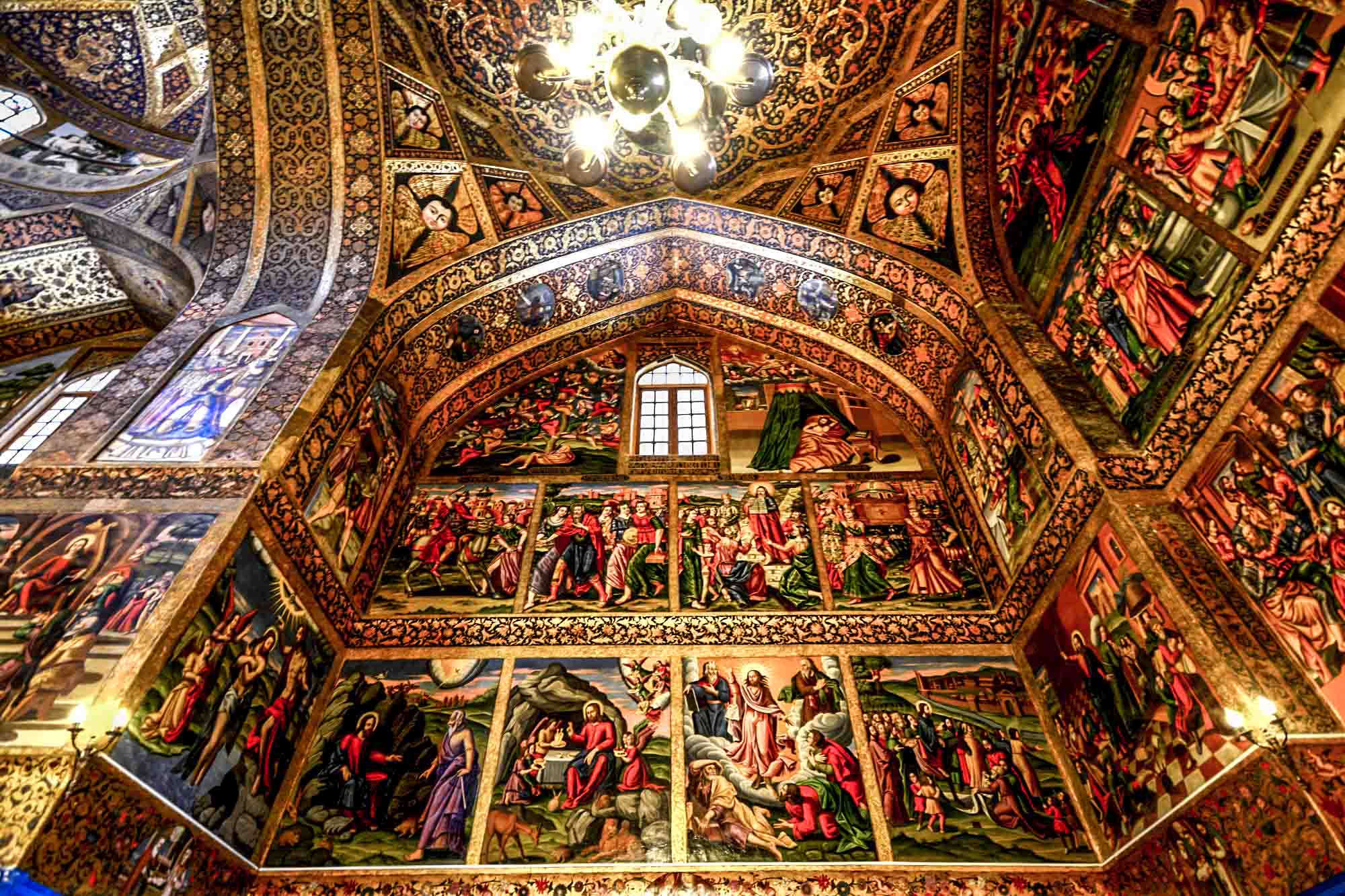Vank Cathedral, located in Julfa district, is the first religious site built by Armenian in Isfahan. The construction of the building dates back to the Safavid dynasty, when Shah Abbas the Great, ruled over Iran. The All Savior’s Cathedral, known as Vank Cathedral, is the center of the Armenian communities of Isfahan and Southern Iran.
The Armenian cathedral in Isfahan is located in Julfa district, the home to Armenian people. Julfa is located in the southern shores of the Zayande Rud River, where many Armenian people are currently living there.
From the 24 churches that Armenians built during the years, only 12 have remained today. The All Savior’s Cathedral, known as Vank Cathedral, has one of the oldest churches of the community. The Cathedral functions as the center of the Armenian communities of Isfahan and Southern Iran. Besides maintaining these communities’ historical wealth, the administrative sections of the cathedral also deal with the management and governance of the Armenian communities.
In addition to the church, there are two museums, a library, the memorial monument for the victims of the Armenian Genocide, a bell tower, and a clock tower inside the cathedral.
Vank Cathedral History
In 1601, Shah Abbas the Great, the Safavid King of Iran, commanded a war against the Ottoman Government. With the retreat of his troops, he ordered all the residential areas that might be reached by the Ottomans, to be evacuated and destroyed. As such, a number of villages and cities populated by Armenians were evacuated. Shah Abbas then immigrated the Armenians to Iran and settled them in different cities, including the capital city, Isfahan.
Here, the Shah had the Armenians settled in a separate neighborhood on the south of the Zayande Rud River. He also let Armenians establish their own churches and schools so as to feel like home. This group of Armenians was mainly merchants, craftsmen, translators, and artisans. Not only they contributed to the flourishing of their neighborhood, but also the Shah’s court.
One of the first churches built in the neighborhood was the St. Hovsep Arevmatatsi Church which is today located inside the cathedral. The first building of the church was built in 1606. Then, in 1655 the construction of a new church in the same place of the old one started and finished in 1664.
The other parts of the cathedral were gradually added during the subsequent years and centuries. The cathedral housed the first printing press in Iran and the Middle East. The printing house was built in 1638, by Khachatur Vardabet Gesaratsi whose statue is installed on the street in front of the cathedral’s entrance. The clock tower was built in 1931 and the older museum and library were first inaugurated in 1906. The cathedral’s new museum was opened in 2019. Also, the memorial monument located in the northern courtyard of the cathedral was built in 1975.
Today, Vank Cathedral is the beating heart of the Armenian community of Isfahan. Its administrative section is in charge of managing the Armenian schools, churches, and properties.

Paintings on Vank Cathedral’s Church Walls
You might not have seen anything like the Cathedral’s church anywhere else. The church is built in the shape of a cross and its entrance is located in its east (all Armenian churches are entered from the east). Once inside the church, a marvelous rush of colors and lights will fill your eyes. The walls all around the church are covered by exquisite frescoes. They are the creations of Armenian masters of the 17th century, who perfected their art in the best art schools of the world such as Italy.
All around, you will see chapters of the old and the new testaments. They are painted in such detail that you can recognize the stories without having to read their descriptions. On the northern wall, you will see an enormous fresco, depicting the hell, the heaven, and the purgatory as described by Christian liturgy. Even the church’s dome is covered by patterned mosaics and the pictures of angels. Some of the stories that you may find on these walls are Adam’s Creation, and Abraham’s sacrificing Ismail.
Italian and Dutch styles of painting can be traced in these pictures. But Armenian and Iranian patterns and painting styles such as arabesques and miniature can also be seen here, especially on the mosaics.

Vank Cathedral’s Museum
On the northeastern part of the courtyard, you will find the cathedral’s museum. In 1905, two rooms were dedicated to keeping old books and manuscripts. In a sense, it functioned as a library and museum. In 1930, the rooms were extended, and it was not until 1971, that the current building was constructed.
At each side of the entrance, you will see this two-storey building that is home to objects from 16th to 20th centuries. Most of the objects have been dedicated to the museum by Armenian families of Isfahan. Here, you can see coins, governmental decrees, manuscripts, items of clothing, and paintings. Additionally, you will find a printing machine dating back to 1841. But one of the most curious items of the museum is right in the middle of the hall. If you approach the microscope located here, you will see a biblical sentence in Armenian written on a strand of hair! The item was prepared by Vahram Hakopian in 1974, by a diamond pen.

Khachatur Kesaratsi Tomb in Vank Cathedral
As you already know, Khachatur Vardapet Kesaratsi introduced the printing press to Isfahan, Iran, and the Middle East. He built the cathedral’s printing house and printed several books in Armenian. His gravestone is located underneath the church’s altar.
Belfry Tower of Vank Cathedral
The bell tower in the southern courtyard, in front of the church’s entrance follows Armenian architectural traditions. The bell tower is topped by an octagonal Armenian style dome.
Vank Cathedral Address
You can find the Vank Cathedral following this address:
Vank Cathedral, Kelisa Vank Street, Hakim Nezami Avenue, Isfahan, Esfahan, Iran
FAQ
Vank Cathedral is open everyday and accepts visitors from 8:30 am to 5:30 pm.
The location of the cathedral in the Armenian quarter, is close to a number of hotels. These include:
• Keshish’s House Hotel
• Chehel Panjereh Hotel
• Persian Kowsar Hotel
• Aseman Hotel
Walking around the neighborhood, you will find plenty of restaurants and cafes. Some of the closest places are:
• Khan Gostar restaurant
• Hermes café and restaurant
• Firooz Sharbatkhaneh
• Ani café
• Romanos café and restaurant
• Arabo sandwich bar
• Star café
• Garni pizzeria
• Newsha Italian restaurant
• Toranj traditional restaurant
• Bros café and restaurant
In addition to many other churches, such as the Bethlehem Church, you will be able to visit:
• Music Museum of Isfahan
• Si-o-Se Pol Bridge
• Khaju Bridge
The other attractions of the town are located further away and it’s better to get there by car.
The Armenian cathedral of Isfahan is the All Savior’s Cathedral, also called Vank Cathedral. It is located in the Armenian neighborhood of the city, in the southern side of the Zayande Rud River.



Comment (0)